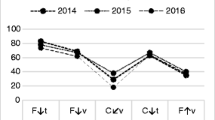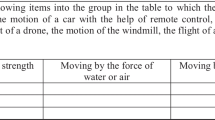Abstract
The ability to generalise principles to a range of situations is generally considered to be important in science education. However, several studies have found that students do not consistently apply their conceptions in the study of mechanics, and that they respond to irrelevant contextual features of the question, such as the type of object in motion. The present study was designed to investigate whether the direction of the motion (i.e. vertical or horizontal) was a contextual feature which influenced students' ideas about the forces involved in motion. The results indicated that 14% of the university science teaching students studied and 25% of the Year 10 students were influenced by the direction of the motion. Some of these students described a ‘motion force’ in one direction (usually vertical) but not the other, while others described forces opposing the motion in one direction (which was always vertical) but not the other.
Similar content being viewed by others
References
Champagne, A., Klopfer, L. & Anderson, J. (1980). Factors influencing the learning of classical mechanics.American Journal of Physics, 48, 1074–1079.
Chi, M., Feltovich, P. & Glaser, R. (1981). Categorisation and representation of physics problems by experts and novices.Cognitive Science, 5, 121–152.
Clement, J. (1982). Students' preconceptions in introductory mechanics.American Journal of Physics, 50(1), 66–71.
Driver, R. (1989). Students' conceptions and the learning of science.International Journal of Science Education, 11(5), 481–490.
Finegold, M. & Gorsky, P. (1991). Students' concepts of force as applied to related physical systems: A search for consistency.International Journal of Science Education, 13, 97–113.
Fischbein, E., Stavy, R. & Ma-Naim, H. (1989). The psychological structure of naive impetus conceptions.International Journal of Science Education, 11, 71–81.
Galili, I. & Bar, V. (1992). Motion implies force: where to expect vestiges of the misconception?International Journal of Science Education, 14, 63–81.
Gunstone, R. F. (1990). ‘Children's science’: A decade of developments in constructivist views of science teaching and learning.Australian Science Teachers Journal, 36(4), 9–19.
Halloun, I. & Hestenes, D. (1985). The initial state of college physics students.American Journal of Physics, 53, 1043–1055.
McCloskey, M. (1983). Intuitive physics.Scientific American, 248, 114–122.
Nussbaum, J. (1989). Classroom conceptual change: philosophical perspectives.International Journal of Science Education, 11, 530–540.
Osborne, R. (1981). Science education: Where do we start?Australian Science Teachers Journal, 28(1), 21–30.
Palmer, D. (1993). How consistently do students use their alternative conceptions?Research in Science Education, 23, 228–235.
Reif, F. (1987). Instructional design, cognition, and technology: applications to the teaching of scientific concepts,Journal of Research in Science Teaching, 24(4), 309–324.
Whitelock, D. (1991). Investigating a model of commonsense thinking about causes of motion with 7 to 16-year-old pupils,International Journal of Science Education, 13, 321–340.
Author information
Authors and Affiliations
Additional information
Specialization: science education
Rights and permissions
About this article
Cite this article
Palmer, D. The effect of the direction of motion on students' conceptions of forces. Research in Science Education 24, 253–260 (1994). https://doi.org/10.1007/BF02356351
Issue Date:
DOI: https://doi.org/10.1007/BF02356351




